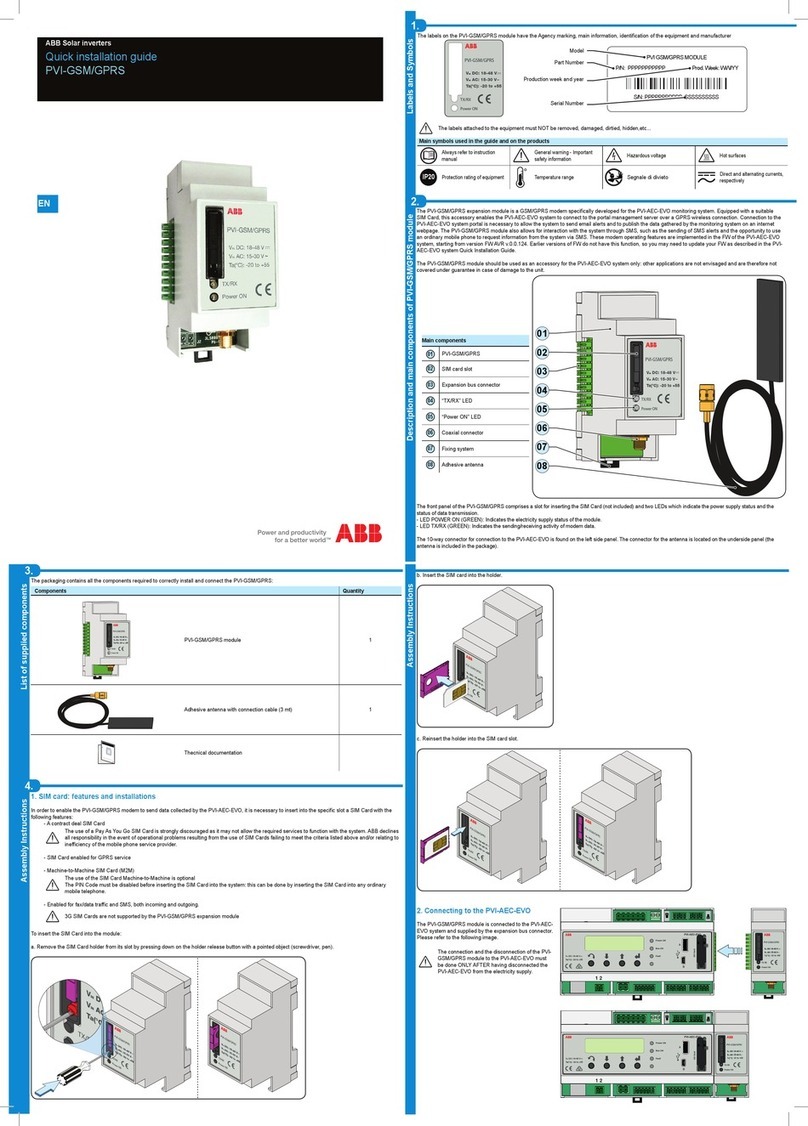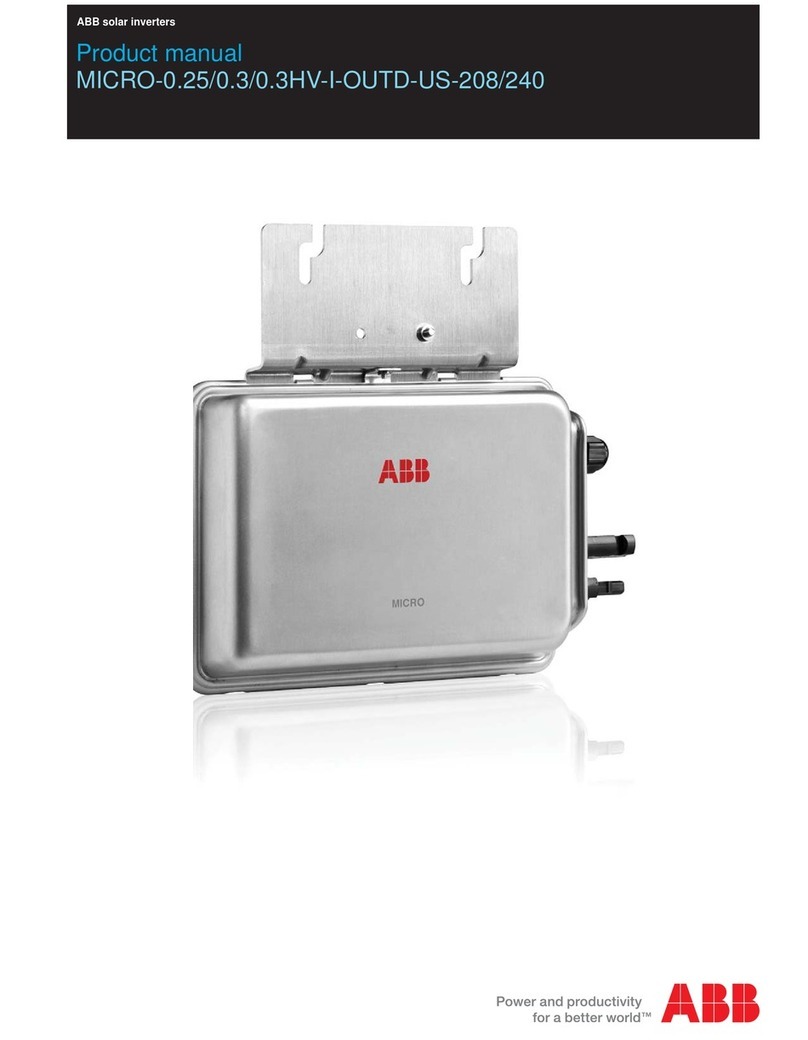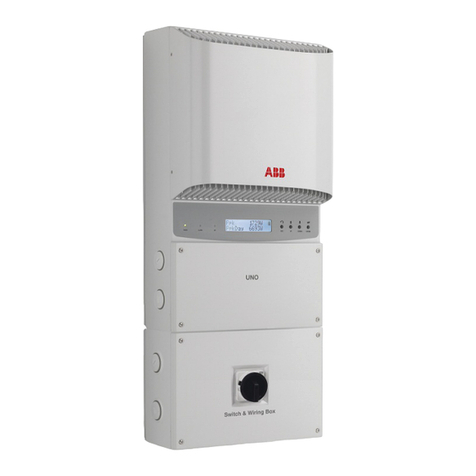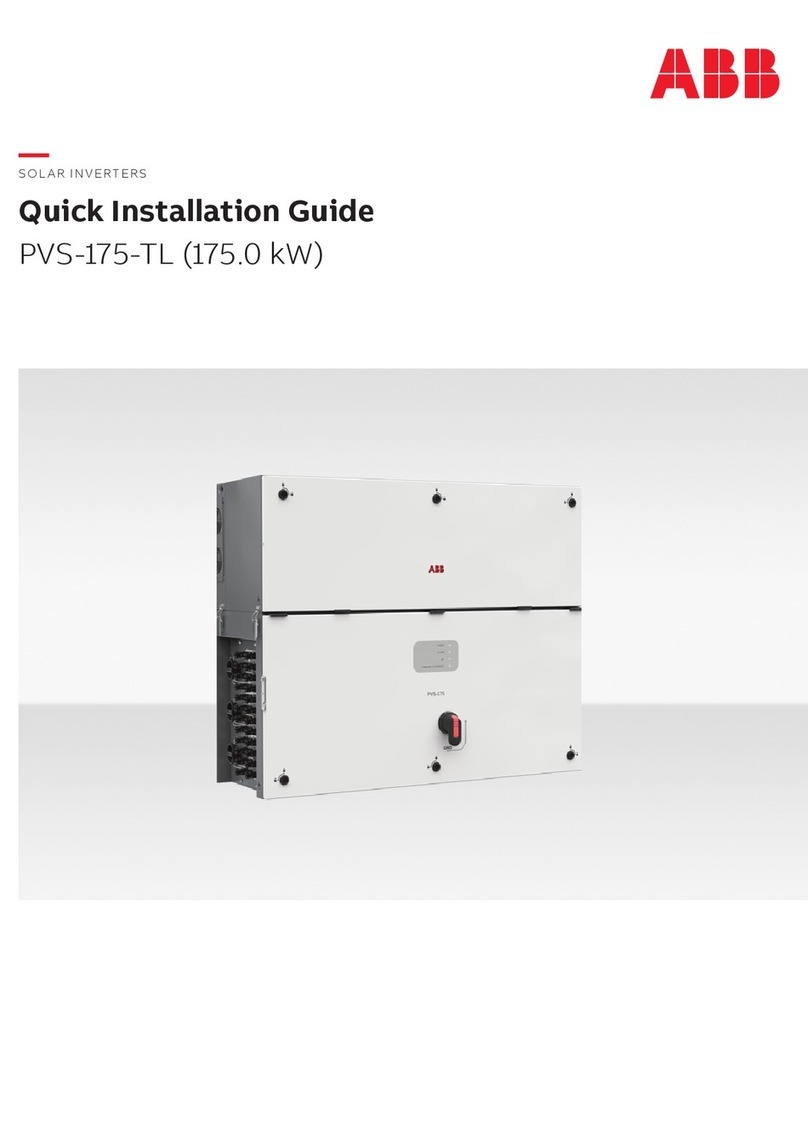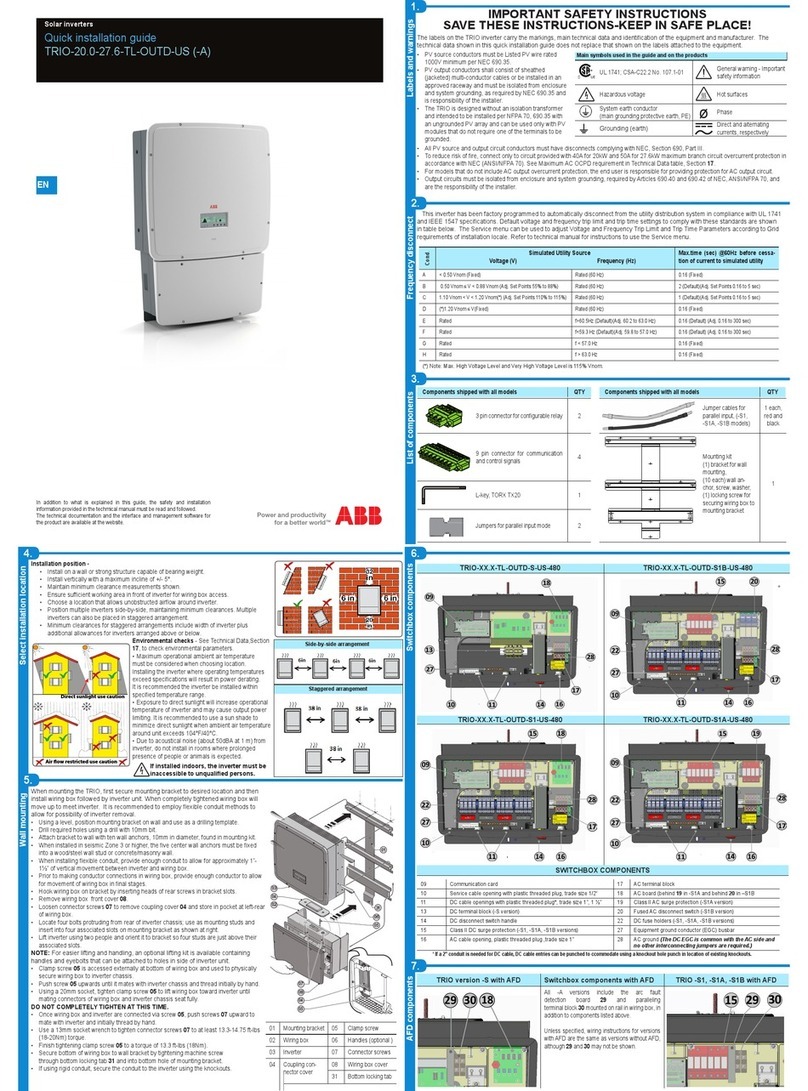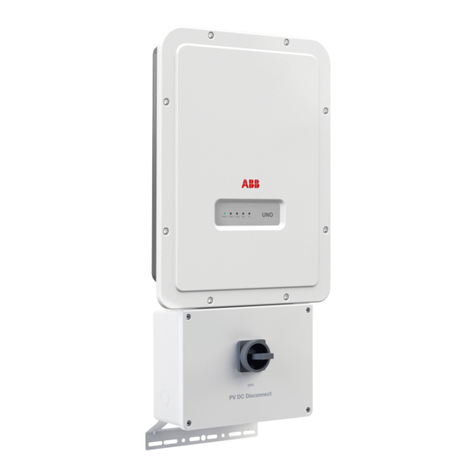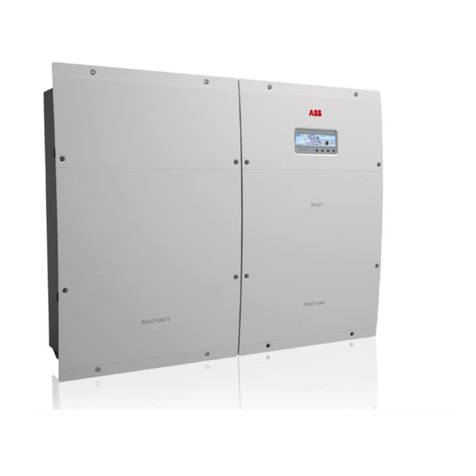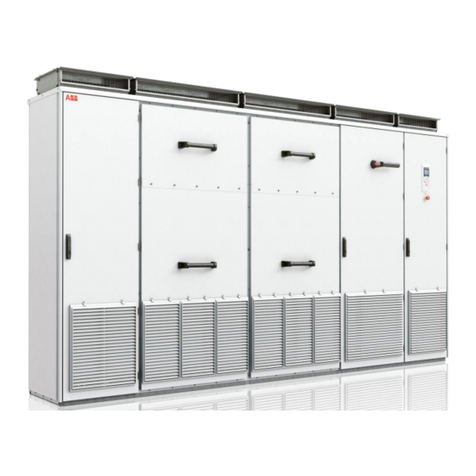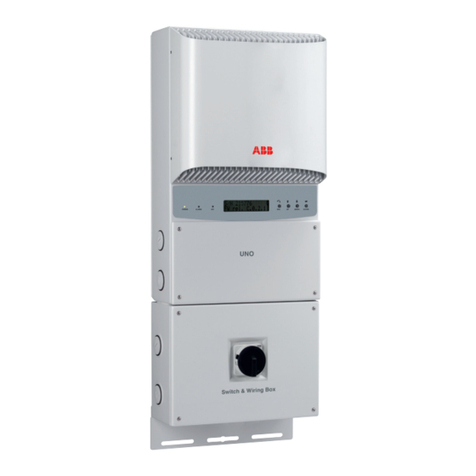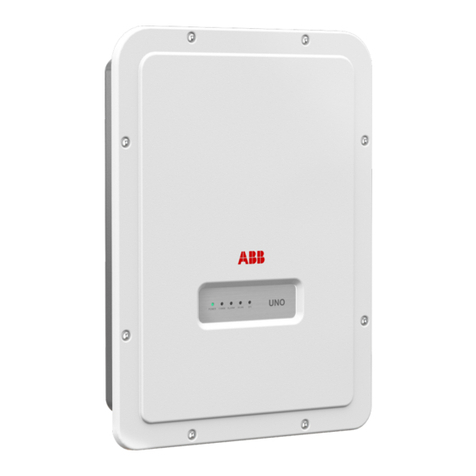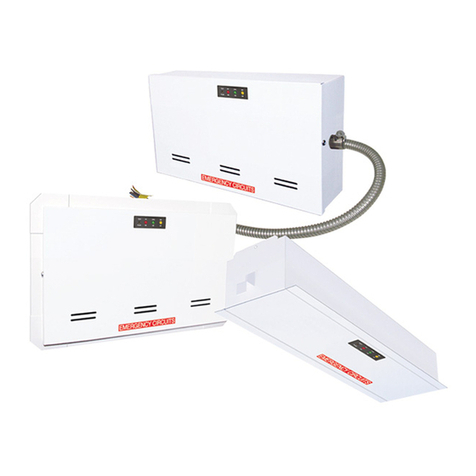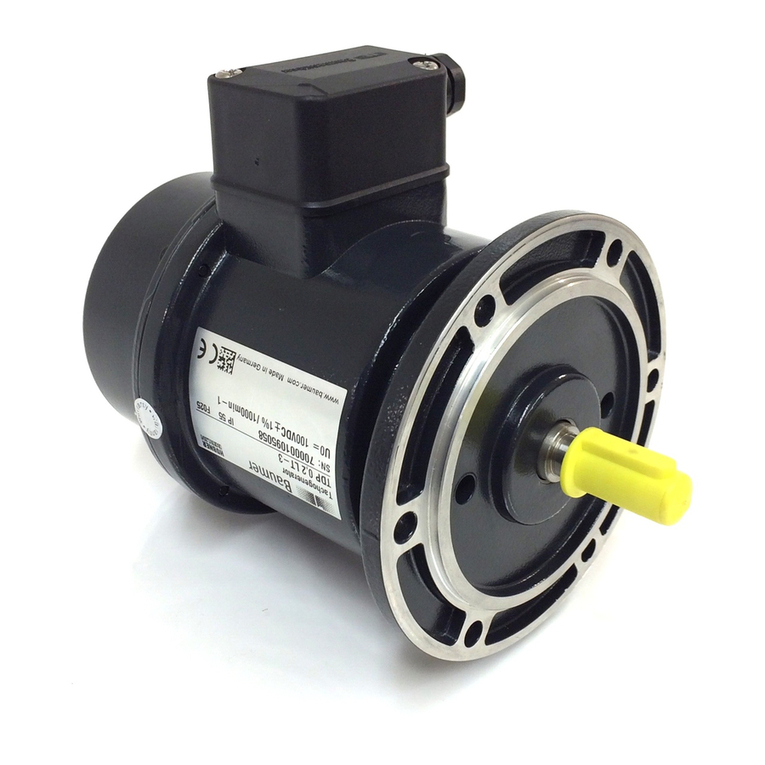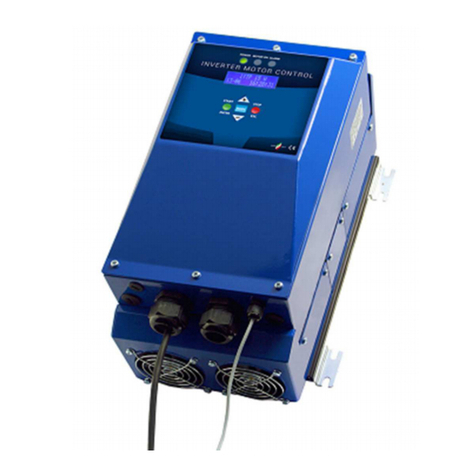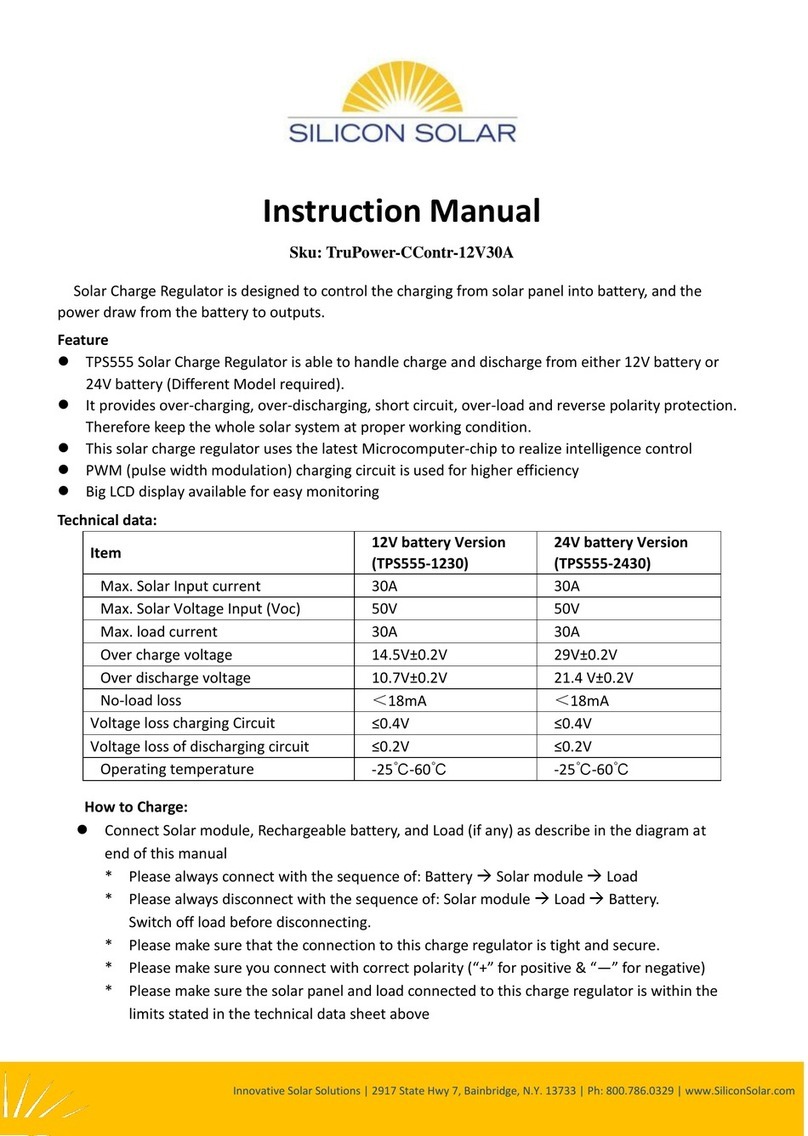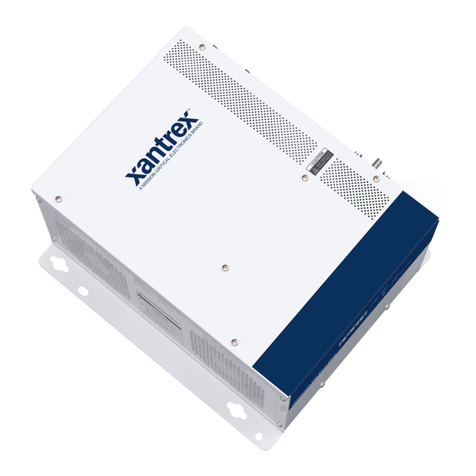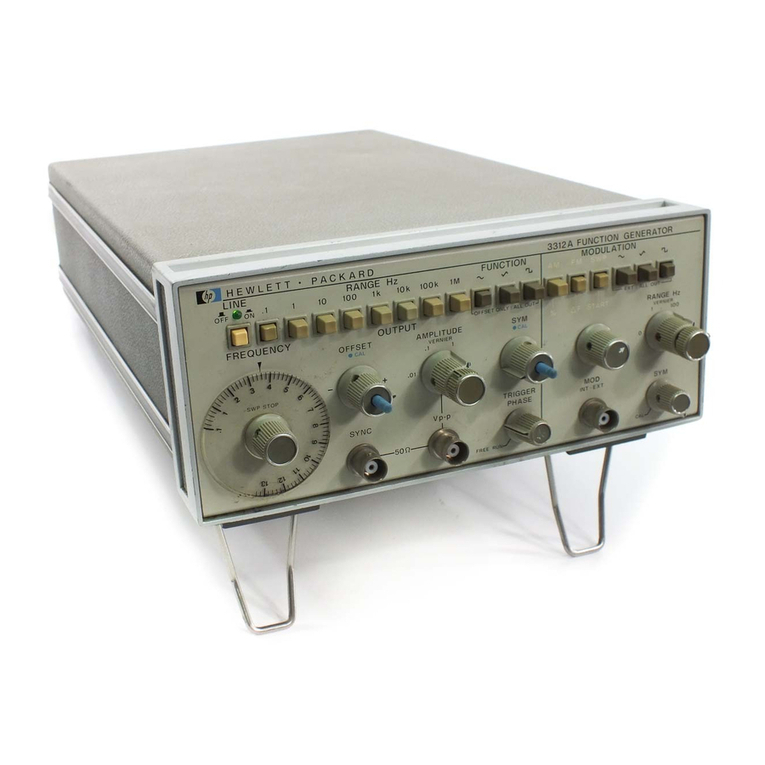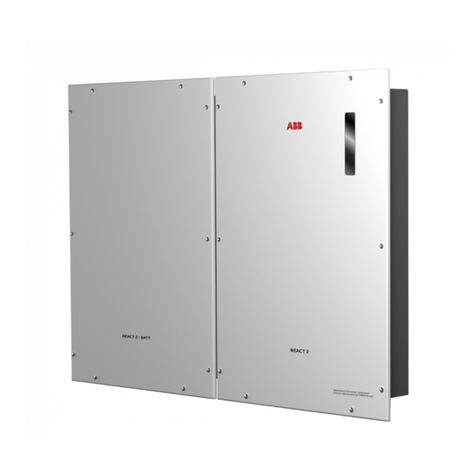
12.
Output connection (AC)
14.
Commissioning
15.
Instruments
PVI-3.8_4.6-I-OUTD-Quick Installation Guide EN-RevB
EFFECTIVE 2014-03-13
© Copyright 2014 ABB. All Rights Reserved.
Specications subject to change without notice.
10.
Connection of the communication and control signals
11.
Line cable and protection devices
16.
Structure of the display menu
17.
Characteristics and technical data
9.
Input connection (DC)
13.
Setting the grid standard
Contact us
www.abb.com/solarinverters
LEDs and BUTTONS, in various combinations, can be used to view the status or carry out complex actions that are described more fully in the manual.
080706
LED
POWER
GREEN On if the inverter is working correctly. Flashes when
checking the grid or if there is insufcient sunlight.
ESC It is used to access the main menu, to go back to the previous menu
or to go back to the previous digit to be edited
LED
ALARM
YELLOW The inverter has detected an anomaly. The anomaly
is shown on the display.
UP It is used to scroll up the menu options or to shift the numerical scale
in ascending order
LED
GFI
RED Ground fault on the DC side of the PV generator. The
error is shown on the display.
DOWN It is used to scroll down the menu options or to shift the numerical
scale in descending order
ENTER It can be used to conrm an action, to access the submenu for the
selected option (indicated by the > symbol) or to switch to the next
digit to be edited
ABB inverters are equipped with a graphic Display
07
, consisting of 2 lines of 16 characters each, which can be used to:
- Display the operating state of the inverter and the statistical data
- Display the service messages for the operator
- Display the alarm and fault messages for the operator
- Changing the settings of the inverter
During the normal operation of the inverter the display cycles through the GENERAL INFORMATION. This information relates to the input and output parame-
ters and the inverter identication parameters. By pressing ENTER it is possible to lock scrolling on a screen to be constantly displayed.
Press ESC to access the three main menus, which have the following functions:
-STATISTICS: Displays the statistics
-SETTINGS: Modify the settings of the inverter
-INFO: View service messages for the operator
Refer to the manual for details regarding use and functions available in the menu
Check for correct polarity in the input strings and absence of any leakage to ground in the PV generator. When exposed to sunlight, the PV
panels supply DC direct voltage to the inverter. The inside of the inverter may only be accessed after the equipment has been disconnected
from the grid and from the photovoltaic generator.
For the string connections it is necessary to use the quick t connectors (multicontact or weidmüller) located on the bottom of the mechanic
22
23
.
- Crimp the Multicontact/Weidmüller MC4/WM4 quick t connector counterparts (supplied) to the string cables or to the cables wired to the DC disconnect
switches (external)
- Connect all the strings included in the design of the system and always check the tightness of the connectors
- If some of the string inputs should not be used you must proceed to verify the presence of covers on DC input connectors and then install them should they be
absent: this operation is necessary for the tightness of the inverter and to avoid damaging the free connector that could be used at a later date.
Load protection breaker (AC disconnect switch) and line cable sizing
To protect the AC connection line of the inverter, we recommend installing a device for protection against over current and leakage with the following character-
istics:
PVI-3.8-TL-OUTD PVI-4.6-TL-OUTD
Type Automatic circuit breaker with differential thermal magnetic protection
Nominal Voltage / Nominal Current 230 Vac / 20 A 230 Vac / 25 A
Magnetic protection characteristic B/C
Number of poles 2
Type of differential protection A/AC
Differential sensitivity 30 mA
ABB declares that the ABB transformerless inverters, in terms of their construction, do not inject continuous ground fault currents and therefore there is no requirement
that the differential protection installed downstream of the inverter be type B in accordance with IEC 60755 / A 2.
Characteristics and sizing of the line cable
Three-pole cable required. The cross-section of the AC line conductor must be sized in order to prevent unwanted disconnections of the inverter from the grid
due to high impedance of the line that connects the inverter to the power supply point.
Cross-section of the line conductor (mm2) Maximum length of the line conductor (mt)
PVI-3.8-I-OUTD PVI-4.6-I-OUTD
4 mm² 15 m 11 m
6 mm² 23 m 16 m
10 mm² 40 m 28 m
16 mm² 64 m 45 m
The values are calculated in nominal power conditions, taking into account:
1. a power loss of not more than 1% along the line. 2. copper cable, with HEPR rubber insulation, laid in free air
max 16 mm²
13 ÷ 21 mm
Each cable which must be connected to the connectors of the communication and control signals must pass through one of the two service cable glands
25
.
An M20 cable gland (that takes cables from 7 mm to 13 mm in diameter) and a gasket with two holes to insert into the cable gland which enables two separate
cables of a maximum diameter of 5 mm to be accommodated, are available.
Warning! To ensure environmental protection IP65 it is necessary to x the cable glands to the inverter chassis with a minimum tightening
torque of 7 Nm
Connection to the RS485 communication line
The RS485 communication port is the inverter’s communication port. The ABB inverters use
an RS485 HALF-DUPLEX communication line made up of two transmission and reception
cables (+T/R and –T/R) and a communication reference cable (RTN): all three cables must be
connected in daisy-chain conguration. The chain connection can be made without distinction
by using the RJ45 connector couples
15
(one for in and one for out) or the terminal block
20
.The last inverter in the daisy chain must be “terminated” or the 120 Ohm communication line
termination resistance must be activated by switching the dip-switch
14
.
Using the alarm terminal block
Terminal block
19
connecting to the congurable relay that allows connection of external
devices which, according to the mode selected in the menu “SETTINGS > Alarm” can, for
example, signal malfunctions. The operating modes that can be set are: Production and Alarm.
The ALARM contact can be used only with systems that ensure a safety isolating additional at least (supplementary insulation in relation to
the DC input voltage)
Using the REM terminal block
The REM terminal block
20
, if suitably congured, allows the “Remote ON/OFF” function to be used: this function allows remote disconnection of the inverter
from the grid
For further information regarding the conguration and use of the communication and control signals terminal block, please see the manual
The inverter commissioning procedure is as follows:
- Switch the integrated switch
21
(version –S) to the ON position or close the external switches: If the input voltage applied to one of the two input channels is
greater than the minimum starting voltage, the inverter will start up.
- The message “Initializing...Please Wait” will be displayed; Depending on the input voltage value, the inverter will show various messages on the display and
change the behaviour of the three LED
06
:
INPUT VOLTAGE DISPLAY MESSAGE LED STATUS DESCRIPTION
Vin < Vstart Waiting Sun
Green = FLASHING
Yellow = OFF
Red = OFF
The input voltage is not sufcient to permit connection to the grid.
Vin > Vstart Missing Grid
Green = FLASHING
Yellow = ON
Red = OFF
There is sufcient input voltage to permit connection to the grid: the in-
verter waits until there is grid voltage to carry out the parallel connection.
The inverter is powered ONLY by the voltage coming from the photovoltaic generator: presence of grid voltage alone IS NOT SUFFICIENT to permit
the inverter to start up.
- With the inverter in “Missing Grid” status, close the AC switch downstream the inverter so as to supply the grid voltage to the inverter: the inverter performs
the grid voltage check, measures the photovoltaic generator insulation resistance against earth and carries out other self-diagnosis checks. During the
checks before the parallel with the grid, the green LED keeps ashing, the others are off.
During the grid voltage check and measurement of the insulation resistance, the values for the grid voltage and frequency and the insulation
resistance measured by the inverter are shown on the display. The inverter ONLY creates a parallel with the grid if the grid parameters fall within the
range foreseen by current regulations and if the insulation resistance falls within the set parameters.
- If the preliminary checks for parallel connection to the grid are successful, the inverter connects to the grid and begins to export power to the grid. At this
stage, the display shows the inverter’s parameters in cycles. The green LED stays lit whereas the others are off.
Before connecting the inverter to the distribution grid it is necessary to set the country standard by manipulating the two rotary switches
12
.
Note: The settings become xed after 24 hours of operation of the inverter (the PV generator simply has to be under power).
Switch Country Grid Standard
(name displayed)
Display
language
Switch Country Grid Standard
(name displayed)
Display
language
1 2 1 2
0 0 NON-ASSIGNED ENGLISH 1 F BRAZIL @ 220V (BRAZIL) ENGLISH
0 1 GERMANY VDE 0126 @ 230V Single Phase (VDE 0126) ENGLISH 2 0 CLC/FprTS 50549 (TURKEY LV) ENGLISH
0 5 ENEL GUIDA @ 230V Single Phase (ENEL) ENGLISH 2 1 ANRE no.30/17.V.2013 (ROMANIA) ENGLISH
0 6 SPAIN RD 1699 @ 230V (RD 1699) SPANISH 2 2 Slovenian (SLOVENIA) ENGLISH
0 7 UK – G83 @ 230V (UK G83) ENGLISH 2 3 CLC/FprTS 50549 (TURKEY HV) ENGLISH
0 8 UK – G59 @ 230V (UK G59) ENGLISH
0
1
2
3
4
5
6
7
8
9
A
B
C
D
E
F
2
1
0
1
2
3
4
5
6
7
8
9
A
B
C
D
E
F
0 9 IRELAND @ 230V (IRELAND) ENGLISH
0 A AUSTRALIA @ 230V (AS 4777) ENGLISH
0DFRANCE @ 230V (FRANCE) FRENCH
0 E NETHERLANDS @ 230V (NETHERL) ENGLISH
0 F GREECE @ 230V (GREECE) ENGLISH
1 0 PORTUGAL @ 230V (PORTUGAL) ENGLISH
1 1 CORSICA @ 230V (CORSICA) FRENCH
1 2 HUNGARY @ 230V (HUNGARY) ENGLISH
1 6 CHECA REPUBLIC @ 230V (CZECH) CZECH
1 7 GERMANY–VDE AR-N-4105 @230V (VDE 4105) GERMAN
1 8 CEI-021 @ 230V INTERNAL Protection (CEI021 IN) ITALIAN
1 9 CEI-021 @ 230V EXTERNAL Protection (CEI021 EX) ITALIAN
1DBELG C10-11 100% @ 230V (C1011 100) FRENCH
1 E BELG C10-11 110% @ 230V (C1011 110) FRENCH
The list of grid standards given in the table was valid at the time of issue of the manual. It will be continually updated as new country standards
with which the inverter is compatible are introduced
Warning! Before performing any of the operations described below, ensure the AC line downstream the
inverter has been correctly disconnected
- Remove the protective lm located on the hole to be used for the AC cables
24
- Insert the M32 cable gland in the hole and secure it using the special M32 lock nut (supplied)
Warning! To ensure environmental protection IP65 it is necessary to x the cable gland to the inverter
chassis with a minimum tightening torque of 8.0 Nm
- Strip 10 mm of sheathing from the AC grid connection cables
- Plug the AC line cable into the inverter, passing it through the previously installed cable gland
- Connect the protective earth (yellow-green) cable to the contact labelled with the symbol on the terminal block
18
Warning! ABB inverters should be earthed (PE) via the terminal with the protective earth label , using a cable with an appropriate cross-
section of the conductor for the maximum ground fault current that the generating system might experience
- Connect the neutral cable (normally blue) to the terminal labelled with the letter N
- Connect the phase cable to the terminal labelled with the letter L
Warning! The AC cables must be tightened on the terminal block with a minimum torque of 1.5 Nm
Once the connection to the terminal board
18
is complete, screw in the cable gland rmly (tightening torque 5.0Nm) and check the tightness.
PVI-3.8-I-OUTD PVI-4.6-I-OUTD
Input
Absolute Maximum Input Voltage (Vmax,abs) 520 V
Input Activation Voltage (Vstart) 200 V (adj. 120...350 V)
Input Operating Range (Vdcmin...Vdcmax)0.7 x Vstart...520 V
Rated DC Input Power (Pdcr) 4000 Wp 4800 Wp
Number of Independent MPPTs 2 (6)
Maximum Input Power for each MPPT (PMPPT max) 3000 W
MPPT Input DC Voltage Range (VMPPT min,f ... VMPPT max,f) at Pacr 160...470 V 180...470 V
Maximum DC Input Current (Idc max) / for each MPPT (IMPPT max)25.0 A / 12.5 A 28.0 A / 14.0 A
Maximum Input Short Circuit Current for each MPPT 22.0 A
Maximum Backfeed current (from AC to DC side) Negligible
Number of DC Inputs Pairs for each MPPT 2
DC Connection Type Connettore PV Tool Free WM / MC4
Input protection
Reverse Polarity Protection Yes, from limited current source
Input Overvoltage Protection for each MPPT - Varistor 2
Photovoltaic Array Isolation Control According to local standard
DC Switch Rating (-S Version) Max. 25.0 A / 600 V
Output
AC Grid Connection Type Monophase
Rated AC Power (Pacr) 3800 W 4600 W
Maximum AC Output Power (Pac max)4200 W (1) 5000 W (2)
Rated AC Grid Voltage (Vacr) 230 V
AC Voltage Range 180...264 Vac (4)
Maximum AC Output Current (Iac max)18.2 A (3) 22.5 A
Inrush Current Negligible
Maximum Output Fault Current <25Arms (100mS)
Rated Output Frequency (fr)50 Hz / 60 Hz
Output Frequency Range (fmin...fmax)47...53 / 57...63 Hz (5)
Nominal Power Factor (Cosphiacr) >0.995 adj. ± 0.9 with Pacr= 3.8 kW >0.995 adj. ± 0.9 with Pacr= 4.6 kW
Total Harmonic Distortion of Current < 2%
AC Connection Type Screw terminal block
Output protection
Anti-Islanding Protection According to local standard
Maximum AC Overcurrent Protection 20.0 A 25.0 A
Output Overvoltage Protection - Varistor 2 (L - N / L - PE)
Operating performance
Maximum Efciency (ηmax) 96.8%
Weighted Efciency (EURO/CEC) 96.5% / -
Power Input Treshold 24.0 W
Stand-by Consumption < 8.0 W
Communication
Wired Local Monitoring PVI-USB-RS232_485 (opz.), PVI-DESKTOP (opz.)
Remote Monitoring PVI-AEC-EVO (opz.), VSN700 Data Logger (opz.)
Wireless Local Monitoring PVI-DESKTOP (opz.) with PVI-RADIOMODULE (opz.)
User Interface LCD Display with 16 characters x 2 line
Environmental
Ambient Temperature Range -25...+60°C /-13...140°F -25...+60°C /-13...140°F
with derating above 50°C/122°F
Storage Temperature -40...80°C (-40...+176°F)
Relative Humidity 0...100% condensing
Environmental pollution classication for external environment 3
Noise Emission < 50 dB(A) @ 1 m
Maximum Operating Altitude without Derating 2000 m / 6560 ft
Environmental Category External
Physical
Environmental Protection Rating IP 65
Cooling Natural
Dimension (H x W x D) 712 x 325 x 222 mm / 28.0 x 12.8 x 8.7 inch
Weight < 24.0 kg / 53.0 lb
Mounting System Wall bracket
Overvoltage Category in accordance with IEC 62109-1 II (DC input) III (AC output)
Safety
Isolation Level HF transformer
Safety Class I
Marking CE (50Hz only)
1. Limited to 3800 W for Germany
2. Limited to 4600 W for Germany
3. Limited to 16 A for UK G83/1 standard
4. The AC voltage range may vary depending on specic country grid standard
5. The Frequency range may vary depending on specic country grid standard
6. Independent MPPT only available with negative input grounded.
Remark. Features not specically listed in the present data sheet are not included in the product

